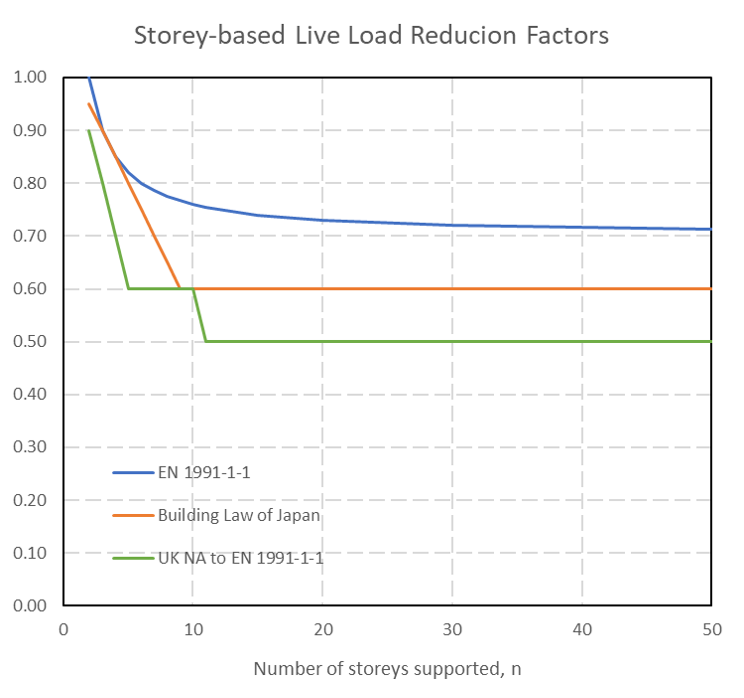Code provisions for live loads are usually prescribed as the maximum probable live load (or imposed load) that the structure (e.g. slab) may experience locally.
However, when considering structural members that support a very large area (or lots of area over multiple floors), it is very conservative to assume that the maximum probable live load will be 100% correlated across all areas.
Why are Live Load Reduction Factors Applied?
Live load reduction factors attempt to account for the lack of correlation in the live loads over a significant area in order to reduce some of the conservatism.
Applications
Live load reduction factors are applied to members which support multiple storeys. These are usually columns and transfer beams.
Japanese Code
The definition of live loads in the Japanese codes already accounts of the lack of correlation of the live loads (床用、架構用、地震用). Refer to the link below:
※ What are Live Loads? Explained in 1-minute
For columns or foundations, the Japanese Building Code allows the following live load reductions depending on the number of storeys which the column supports:
| Number of floors supported | Live Load reduction factor |
| 2 | 0.95 |
| 3 | 0.90 |
| 4 | 0.85 |
| 5 | 0.80 |
| 6 | 0.75 |
| 7 | 0.70 |
| 8 | 0.65 |
| 9 or more | 0.60 |
Eurocode
The Eurocode live load reduction factors are described in EN 1991-1-1. These allow a reduction based on the number of storeys supported by a member. This is described by the following equation:
Where Ψ0 is based on the occupancy category in Table A1.1 of EN 1990, but generally 0.7 for most uses (residential, office, shopping, etc.) except storage.
Actually, the above approach only provides a maximum reduction factor of 0.7 for an element supporting even more than 20 storeys. This reduction is quite modest and still relatively conservative compared to other code approaches.
However, in many European countries, this approach is not adopted. Instead, live load reductions are based on the total tributary area supported by a member, rather than the number of storeys (it could be argued that this is a more rational approach). The following equation is used:
Where A is the area supported by the member in units of m2. This provides a live load reduction of up to 0.5, except for Category C and D occupancies (congregations and shopping area).
Just like the UK, individual European countries will have their own National Annex with different rules and equations for the live load reduction factors. For the purposes of this article, only the equations suggested in the UK National Annex are described below.
United Kingdom
https://www.newsteelconstruction.com/wp/wp-content/uploads/TechPaper/TechNSCMay13.pdf
The UK National Annex to EN 1991-1-1 provides the following live load reduction (α) based on the number of supported storeys:
αn = 0.6 up to and including 10 storeys
αn = 0.5 more than 10 storeys
American Codes
The live load reductions specified in US codes are described in ASCE 7. These depend on the type of member (e.g. column, beam, etc.) and are based on the tributary area supported by that member. The reductions are described by the following equation from ASCE 7-22 in SI format...
Where A is the tributary area supported by the member and K_LL is a factor which depends on the type of member in question. Refer to ASCE 7-22 Table 4.7-1 for more information.
The above general equation allows a reduction factor of 0.4 for elements supporting two storeys or more, and only down to 0.5 for members supporting a single storey.
Storey-based LLR Comparison
The below graph presents a comparison for storey-based live load reductions (LLR), currently limited to the Eurocode, UK National Annex and Japanese building codes:
